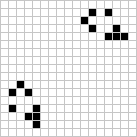Noah's ark
Noah's ark is a diagonal puffer that was found by Charles Corderman in 1971. It consists of two mutually stabilizing switch engines and is thus an ark. Its name comes from the variety of objects it leaves behind - in particular, every 1344 generations it produces 42 blocks, 40 blinkers, 22 beehives, eight loaves, four gliders, two boats, two block on tables, two long boats, two ships, and one beacon.
| Noah's ark | |||
| |||
| View static image | |||
| Pattern type | Puffer | ||
|---|---|---|---|
| Number of cells | 16 | ||
| Bounding box | 15×15 | ||
| Direction | Diagonal | ||
| Period | 1344 | ||
| Speed | c/12 | ||
| Discovered by | Charles Corderman | ||
| Year of discovery | 1971 | ||
| |||
| |||
| |||
A 3-glider synthesis of a switch engine discovered by Luka Okanishi in March 2017 allowed for a 6-glider synthesis of Noah's ark.
Gallery
 The debris left behind every 1344 generations |
|
gollark: Office Online?
gollark: You can only limit spying in 10.
gollark: Barely configurable, and keeps spying.
gollark: Er.
gollark: ^
External links
- Noah's ark at the Life Lexicon
- Noah's ark at Adam P. Goucher's Catagolue (linear growth)
This article is issued from Conwaylife. The text is licensed under Creative Commons - Attribution - Sharealike. Additional terms may apply for the media files.
